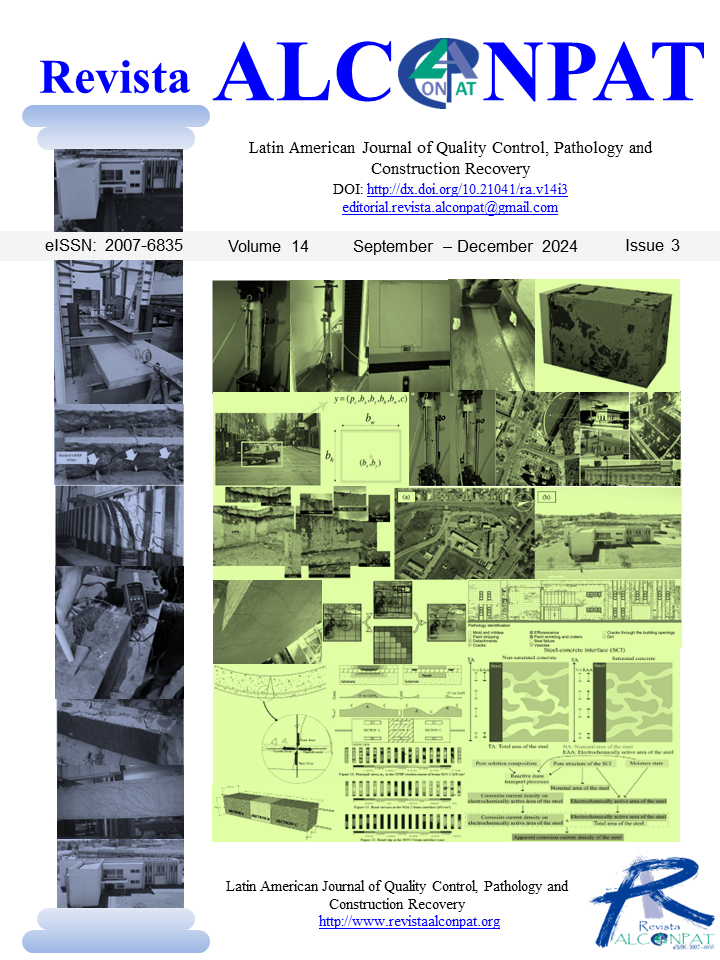Behavior prediction of reinforced concrete beams shear strengthened with CFRP
DOI:
https://doi.org/10.21041/ra.v14i3.753Keywords:
reinforced concrete structures; structural reinforcement; CFRP; FEM; ANSYSAbstract
This work presents the computational modeling of reinforced concrete beams, strengthened to shear with carbon fiber-reinforced polymers (CFRP), using the finite element method (FEM) and the customized ANSYS software, version 19.2. It is important to emphasize that contact elements and bilinear cohesive zone models provided by ANSYS were used to model the concrete-reinforcement interface. These models were used to identify the modes of premature failure caused by the debonding of the reinforcement, which causes poor use of the CFRP's resistance properties. The structural elements used in this analysis were twelve simply supported reinforced concrete beams, without and with shear reinforcement using CFRP, which were experimentally tested by Khalifa (1999). From the analysis of the results, it was observed that the developed numerical models were able to accurately predict the behavior of the simulated beams, both in terms of load-displacement, as well as the load and rupture mode of the beams.
Downloads
References
ANSYS, Inc. (2021), ANSYS Help System, version 19.2.
Fédération Internationale du Betón (2013), fib Model Code for Concrete Structures 2010. 434 p.
Hoffman, I. S.; Lazzari, B. M.; Campos, A.; Lazzari, P. M.; Pacheco, A. R. (2022), Finite element numerical simulation of a cable-stayed bridge construction through the progressive cantilever method. Structural Concrete, v. 23 (2), p. 632-651. https://doi.org/10.1002/suco.202100662
Khalifa, A. (1999), Shear performance of reinforced concrete beams strengthened with advanced composites. 175 p. PhD Thesis, Structural Engineering Department, Alexandria University, Egypt.
Khalifa, A.; Belarbi, A.; Nanni, A. (2000), Shear Performance of RC Members Strengthened with Externally Bonded FRP Wraps, Proc., 12th World Conference on Earthquake Engineering, Jan 30- Feb 04, Auckland, New Zealand, paper 305,10 p.
Khalifa, A.; Nanni, A. (2002), Rehabilitation of rectangular simply supported RC beams with shear deficiencies using CFRP composites. Construction and Building Materials, v. 16, n. 3, p. 135-146. https://doi.org/10.1016/S0950-0618(02)00002-8
Lazzari, B. M.; Campos Filho, A.; Lazzari, P. M.; Pacheco, A. R. (2017a), Using element-embedded rebar model in ANSYS for the study of reinforced and prestressed concrete structures. Computers and Concrete, v. 19, p. 347-356. https://doi.org/10.12989/cac.2017.19.4.347
Lazzari, P. M.; Campos Filho, A.; Lazzari, B. M.; Pacheco, A. R. (2017b), Structural analysis of a prestressed segmented girder using contact elements in ANSYS. Computers and Concrete, v. 20, p. 319-327. https://doi.org/10.12989/cac.2017.20.3.319
Lazzari, P. M.; Campos Filho, A.; Lazzari, B. M.; Pacheco, A. R.; Gomes, R. (2019), Numerical simulation of the constructive steps of a cable-stayed bridge using ANSYS. Structural Engineering and Mechanics, v. 69, p. 269-281. https://doi.org/10.12989/sem.2019.69.3.269
Machado, G. G., Campos Filho, A., Lazzari, P. M., Lazzari, B. M.; Pacheco, A. R. (2023), Numerical simulation by the finite element method of the constructive steps of a precast prestressed segmental bridge. Structural Engineering and Mechanics, v. 85, n. 2, p. 163-177. https://doi.org/10.12989/sem.2023.85.2.163
Medeiros, M. V. (2019), Simulação numérica do comportamento de peças fletidas reforçadas com PRFC. 194 p. Dissertação (Mestrado em Engenharia Civil) – Programa de Pós-Graduação em Engenharia Civil. Universidade Federal do Rio Grande do Sul, Porto Alegre.
Mhanna, H. H., Hawileh, R. A., Abdalla, J. A. (2021), Shear behavior of RC T-beams externally strengthened with anchored high modulus carbon fiber-reinforced polymer (CFRP) laminates. Composite Structures, v. 272, p. 114198. https://doi.org/10.1016/j.compstruct.2021.114198
Ouyang, Z., Li, G. (2009), Cohesive zone model based analytical solutions for adhesively bonded pipe joints under torsional loading. International Journal of Solids and Structures, v. 46, n. 5, p. 1205-1217. https://doi.org/10.1016/j.ijsolstr.2008.10.021
Sarturi, F. D. M. (2014), Simulação computacional de estructuras de concreto reforçadas com aço e compósitos de fibra de carbono. 234 p. Dissertação (Mestrado em Mecânica Computacional) – Programa de Pós-Graduação em Métodos Numéricos em Engenharia. Universidade Federal do Paraná, Curitiba.
Soares, P. B. (2022), Simulação através do Método dos Elementos Finitos do reforço ao esforço cortante de vigas de concreto utilizando polímeros reforçados com fibras de carbono. 215 p. Dissertação (Mestrado em Engenharia Civil) – Programa de Pós- Graduação em Engenharia Civil. Universidade Federal do Rio Grande do Sul, Porto Alegre.
Soares, P. B., Lazzari, P. M., Campos Filho, A., Lazzari, B. M., Pacheco, A. R. (2023), Identification of the failure modes of CFRP shear-strengthened reinforced concrete beams by the finite element method. IBRACON Structures and Materials Journal, v. 16, n. 3, p. 1-21. https://doi.org/10.1590/S1983-41952023000300004
Titello, E. P. (2020), Análise da confiabilidade de vigas em concreto armado reforçado com fibras de aço em relação aos esfuerzos transversais. 161 p. Dissertação (Mestrado em Engenharia Civil) – Programa de Pós- Graduação em Engenharia Civil. Universidade Federal do Rio Grande do Sul, Porto Alegre.
Published
How to Cite
Issue
Section
License
_______________________________
License in effect from September 2020
You are free to:
- Share — copy and redistribute the material in any medium or format for any purpose, even commercially.
- Adapt — remix, transform, and build upon the material for any purpose, even commercially.
- The licensor cannot revoke these freedoms as long as you follow the license terms.
Under the following terms:
- Attribution — You must give appropriate credit , provide a link to the license, and indicate if changes were made . You may do so in any reasonable manner, but not in any way that suggests the licensor endorses you or your use.
- No additional restrictions — You may not apply legal terms or technological measures that legally restrict others from doing anything the license permits.
Notices:
You do not have to comply with the license for elements of the material in the public domain or where your use is permitted by an applicable exception or limitation .
No warranties are given. The license may not give you all of the permissions necessary for your intended use. For example, other rights such as publicity, privacy, or moral rights may limit how you use the material.





















.png)














